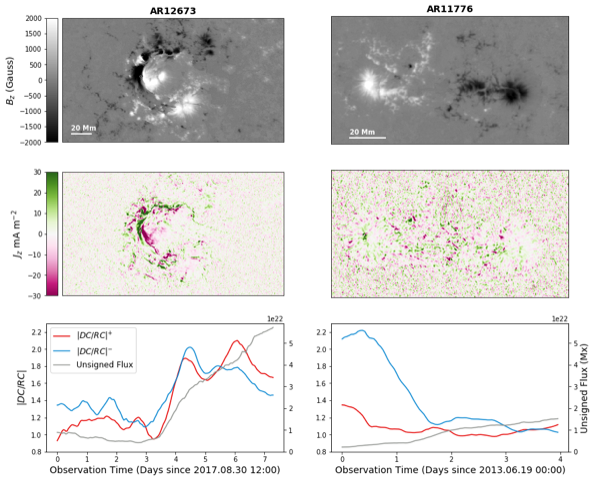Electric Current Neutralization and Eruption
From RHESSI Wiki
| Nugget | |
|---|---|
| Number: | 391 |
| 1st Author: | Ellis AVALLONE |
| 2nd Author: | Xudong SUN |
| Published: | 12 October 2020 |
| Next Nugget: | Hot flare onsets |
| Previous Nugget: | Prediction of Solar Cycle 25 |
| List all | |
Contents |
Introduction
Solar eruptions are energetic events that send large amounts of high-energy radiation and charged particles through interplanetary space. If one of these eruptions is directed towards Earth, satellites, astronauts, and electrical grids can be negatively affected. While there has been a significant effort to predict solar eruptions using techniques like machine learning, we still don't fully understand the environments where these eruptions originate.
Active regions (ARs) are a primary source of solar eruptions. They are rooted in sunspots and host strong magnetic fields that can include a structure described as a flux rope, a tube-like region of space containing a twisted magnetic field. Like all evolving magnetic fields, flux ropes are current-carrying structures and contain direct currents, which connect AR magnetic polarity centers, and return currents, which surround and oppose the direct currents. Figure 1 shows a pre-emergence flux rope and a post-emergence flux rope along with their associated currents.

It's a well-known fact that the "free" magnetic energy associated with AR electric currents drives solar eruptions, but its unclear how well these driving currents are neutralized. How close is the ratio of direct to return currents in each magnetic polarity to unity? The degree of current neutralization in the corona has been debated for several decades. Some theoretical studies have argued that the average net current density in a single magnetic polarity of ARs is zero, i.e. the current is totally neutralized. Other theoretical studies and recent numerical simulations have shown that non-neutralized currents emerge alongside the development of substantial magnetic shear along an ARs polarity inversion line (PIL). A pilot observational study using a sample of four ARs (Ref. [1]; see also earlier Nuggets A and B) tackled this question, but more work needs to be done to constrain this parameter.
Results
In this work, we build off of these previous studies by analyzing a sample of 15 flare-active and 15 flare-quiet ARs in the SHARP dataset from the Helioseismic and Magnetic Imager on the Solar Dynamics Observatory (SDO/HMI). We start by calculating the electric current density within an AR from HMI vector magnetograms by using Ampere's Law. From these current-density maps, we determine the ratio between direct and return currents (|DC/RC|) in each magnetic polarity and in the full AR. By doing this for our sample of 15 flare-active and 15 flare-quiet ARs, we can compare the degree of current neutralization to flare productivity.
We compare the degree of current neutralization between flare-active and flare-quiet ARs and find that the degree of current neutralization differs between these two populations at a 90% confidence level. We also compare the degree of PIL shear and find that flare-active ARs are more sheared than flare-quiet ARs, also at a 90% confidence level. Figure 2 shows the distributions of current neutralization and PIL shear for our full sample.
We also focus on examples (eg. Figure 3) of flare-active and flare-quiet ARs to look for other trends within the two populations. For flare-active ARs, we observe coherent current ribbons around the PIL in their current density maps. This indicates the presence of a coherent flux rope, which is a necessary condition for eruption. We dont observe this trend in flare-quiet ARs, where the currents are more evenly distributed.

Finally, we analyze contributions to systematic uncertainty in our results. We compare the region selection method we use to compute the degree of current neutralization to the region selection method used in a previous study, which computationally determined what regions of AR magnetic fields contributed to flaring events. Instead, we use the entire AR cutout from the SHARP dataset and isolate strong magnetic fields using a threshold of 200 Gauss. We find that our method decreases the degree of current neutralization by a factor of 2. However, we do not expect this shift to change the trends observed between flare-active and flare-quiet ARs.
Conclusions
By measuring the degree of current neutralization for 30 solar ARs, we have determined that this parameter is a good proxy for assessing an AR's ability to erupt. The results from our observations also agree with previous theoretical and observational studies. For more details, check out our full paper (Ref. [2]).
References
[1] "Electric-current Neutralization, Magnetic Shear, and Eruptive Activity in Solar Active Regions"
[2] "Electric Current Neutralization in Solar Active Regions and Its Relation to Eruptive Activity"
| RHESSI Nugget Date | 12 October 2020 + |
| RHESSI Nugget First Author | Ellis AVALLONE + |
| RHESSI Nugget Index | 391 + |
| RHESSI Nugget Second Author | Xudong SUN + |
